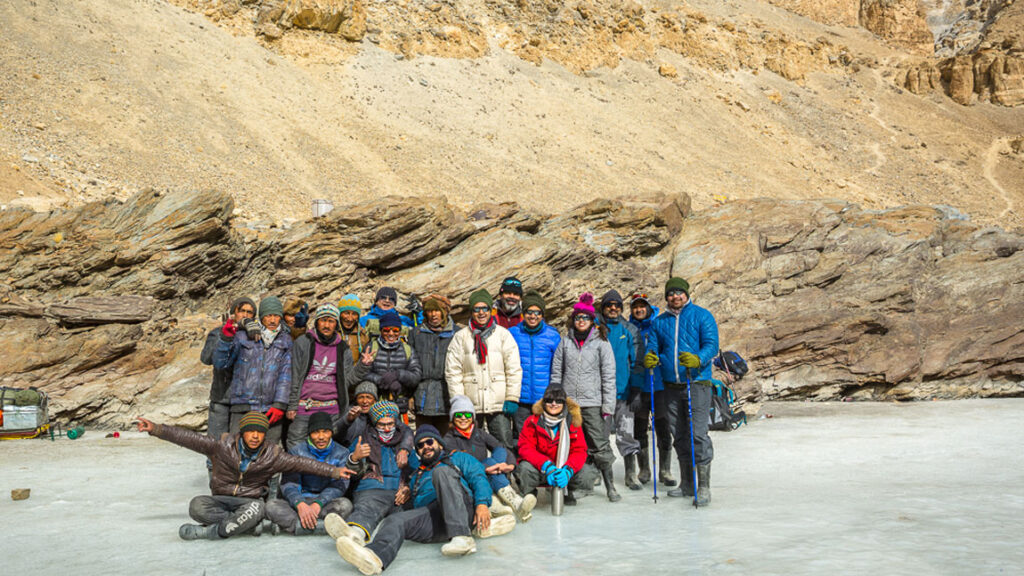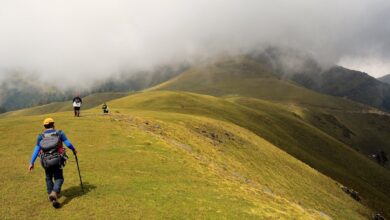Prepare for the Chadar Trek: A Complete Trekker’s Guide
Planning the Chadar Trek, an extraordinary journey on the frozen Zanskar River in India, requires thorough preparation and consideration. This detailed guide will cover everything you need to know to ensure a safe, enjoyable, and memorable trekking experience.
Overview of the Chadar Trek
The Chadar Trek in Zanskar River is renowned for its breathtaking landscapes and unique winter experience. During winter, the Zanskar River freezes, allowing trekkers to walk on its icy surface while surrounded by dramatic cliffs and serene snow-covered landscapes. This trek not only tests your physical endurance but also immerses you in the rich culture of the Zanskar Valley.

1. Timing and Duration
Best Season
- Ideal Months: Late January to mid-March is the best time to undertake the Chadar Trek. The river is typically fully frozen, providing the best conditions for trekking.
- Temperature Range: Be prepared for extreme cold; temperatures can drop as low as -30°C. Daytime temperatures are usually slightly warmer but still frigid.
Duration
- Trek Length: The trek usually lasts between 9 to 12 days, depending on the itinerary and your pace. Each day involves walking 10-15 kilometers, which can vary based on conditions.
2. Permits and Regulations
Trekking Permits
- Required Permits: To trek in the Zanskar Valley, you will need specific permits. These can be obtained from the local tourism office in Leh.
- Protected Area Permit: If you are a foreign national, you might require a Protected Area Permit (PAP). Check with your trekking agency or the tourism office for the latest regulations.
3. Physical Preparation
Fitness Level
- Importance of Conditioning: The Chadar Trek is physically demanding, so a good fitness level is crucial.
- Training Regimen:
- Cardiovascular Fitness: Engage in activities like running, cycling, or swimming. Aim for at least 30-45 minutes of cardio most days.
- Strength Training: Focus on leg and core workouts. Exercises like squats, lunges, and planks will help build the necessary strength.
- Endurance Training: Go on long hikes with a loaded backpack to simulate the trekking conditions. Aim for hikes of 10-15 kilometers to build stamina.
Acclimatization
- Spending Time in Leh: Arrive in Leh at least 2-3 days before your trek. This allows your body to acclimatize to the high altitude (approximately 3,500 meters).
- Gentle Activities: Engage in light activities, such as walking around Leh, to help with acclimatization.
4. Packing List
Packing appropriately is crucial for your comfort and safety during the trek. Here’s a comprehensive packing list:
Clothing
- Base Layers: Thermal tops and bottoms are essential for warmth.
- Insulating Layers: Fleece jackets or down jackets to retain body heat.
- Outer Layer: A waterproof and windproof jacket and pants to protect against snow and wind.
- Accessories:
- Warm hat that covers the ears.
- Waterproof gloves and insulated liners.
- A neck gaiter or balaclava.
- Multiple pairs of thick, moisture-wicking socks.
- Footwear: Insulated, waterproof trekking boots with good traction. Consider gaiters to prevent snow from entering your boots.
Sleeping Gear
- Sleeping Bag: A high-quality sleeping bag rated for extreme cold (at least -20°C).
- Sleeping Pad: An insulated sleeping pad to provide comfort and warmth from the cold ground.
Camping Gear
- Tent: If not provided by your trekking agency, bring a lightweight, four-season tent.
- Cooking Equipment: If self-catering, include a portable stove, cooking utensils, and fuel.
Safety and First Aid
- First Aid Kit: Include bandages, antiseptics, pain relievers, altitude sickness medication (like Diamox), and personal medications.
- Emergency Gear: Carry a whistle, signal mirror, and a basic repair kit for your gear.
Other Essentials
- Trekking Poles: Helpful for maintaining balance on icy terrain.
- Hydration System: Insulated water bottles to prevent freezing. Consider a hydration bladder with insulation.
- Food Supplies: High-energy snacks such as nuts, energy bars, and dried fruits.
- Electronics: Camera, power banks, and possibly a solar charger. Ensure all devices are protected from the cold.
5. Choosing a Trekking Agency
Research and Selection
- Reputation: Look for a trekking agency with a solid reputation and experience in organizing the Chadar Trek. Check reviews and testimonials from previous trekkers.
- Inclusions in Packages: Ensure you understand what is included in the package, such as meals, accommodation, gear, and guides.
- Local Guides: An experienced local guide can enhance your experience by providing valuable insights into the area, its culture, and ensuring safety throughout the trek.
6. Travel Arrangements
Getting to Leh
- Flights: Fly into Leh, which is well connected to major cities in India. Book your flight well in advance to secure the best rates.
- Buffer Days: Allow for extra days in your itinerary in case of flight cancellations or delays due to weather conditions.
Local Transport
- Transport to Trek Start: Arrange for transport from Leh to the trek starting point, usually Shingra Karpokhar or another village in the Zanskar Valley. Many trekking agencies provide this service as part of their package.
7. Trekking Route and Itinerary
Typical Itinerary
- Sample Itinerary:
- Day 1: Arrival in Leh, acclimatization, and briefing about the trek.
- Day 2: Travel to the starting point (e.g., Shingra Karpokhar) and start the trek.
- Days 3-8: Trekking along the Chadar with overnight stops at camps or local villages like Tibb, Nyerak, and others. Each day involves trekking 10-15 km.
- Day 9: Return to the starting point.
- Day 10: Travel back to Leh and unwind.
Camp Locations
- Camps are usually set up near scenic spots along the river, providing opportunities to experience the stunning landscapes and local culture.
8. Food and Hydration
Meals
- With an Agency: If you choose to trek with an agency, they will provide meals. Expect hearty meals with local ingredients, including rice, lentils, bread, and vegetables.
- Self-Catering: If self-catering, plan simple meals that require minimal cooking time. Instant noodles, soups, and pre-packed meals can be good options.
Hydration
- Water Sources: In the cold, staying hydrated is crucial. You can melt snow for drinking water or use purification tablets.
- Warm Beverages: Hot drinks, such as tea and soup, can help keep you warm and hydrated.
9. Safety Precautions
Weather Awareness
- Regular Updates: Always check the weather forecast before heading out each day. Be prepared for sudden changes in conditions.
- Clothing Layers: Wear layers that can be adjusted based on activity levels and weather changes.
Altitude Sickness
- Symptoms: Be aware of symptoms of altitude sickness, including headaches, nausea, and dizziness. If symptoms worsen, descend immediately and seek help.
- Emergency Plans: Know the nearest points for evacuation and ensure your guide has a plan in place for emergencies.
10. Cultural Respect and Environmental Care
Local Customs
- Respect Traditions: Familiarize yourself with the local customs and traditions of the Zanskar Valley. Engage with the locals respectfully and be mindful of their way of life.
- Photography Etiquette: Always ask for permission before taking photos of people or their property.
Environmental Responsibility
- Leave No Trace: Follow the Leave No Trace principles. Carry out all trash, avoid making fires, and minimize your impact on the environment.
- Wildlife Protection: Do not disturb wildlife or natural habitats during your trek.
Conclusion
The Chadar Trek is a unique adventure that combines physical challenge with stunning natural beauty and cultural immersion. With the right preparation, including physical training, careful packing, and respectful engagement with local cultures, you can ensure a rewarding experience on this unforgettable trek. Embrace the journey, and enjoy the breathtaking landscapes of the Zanskar Valley!
- Also Read: Planning the Dayara Bugyal Trek


